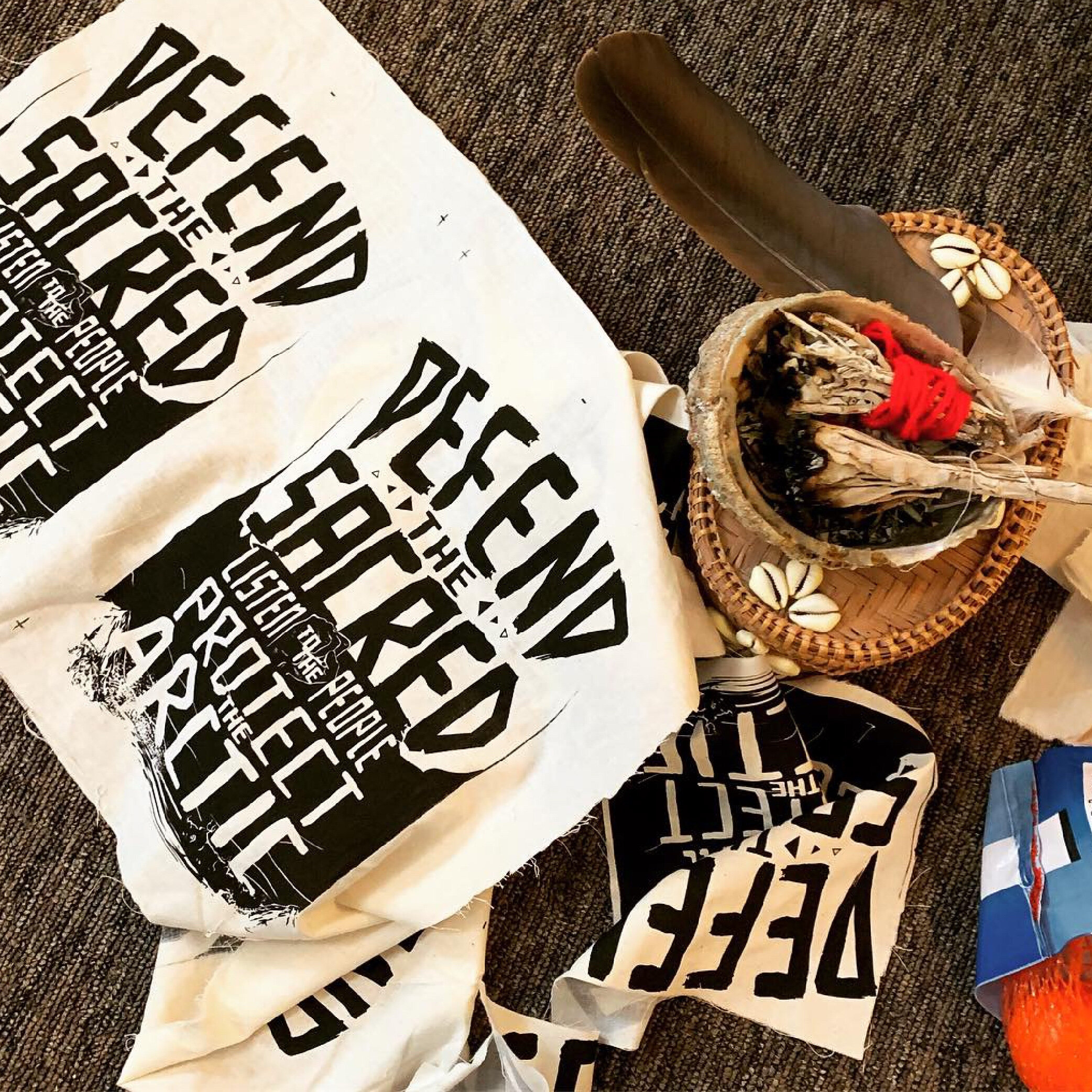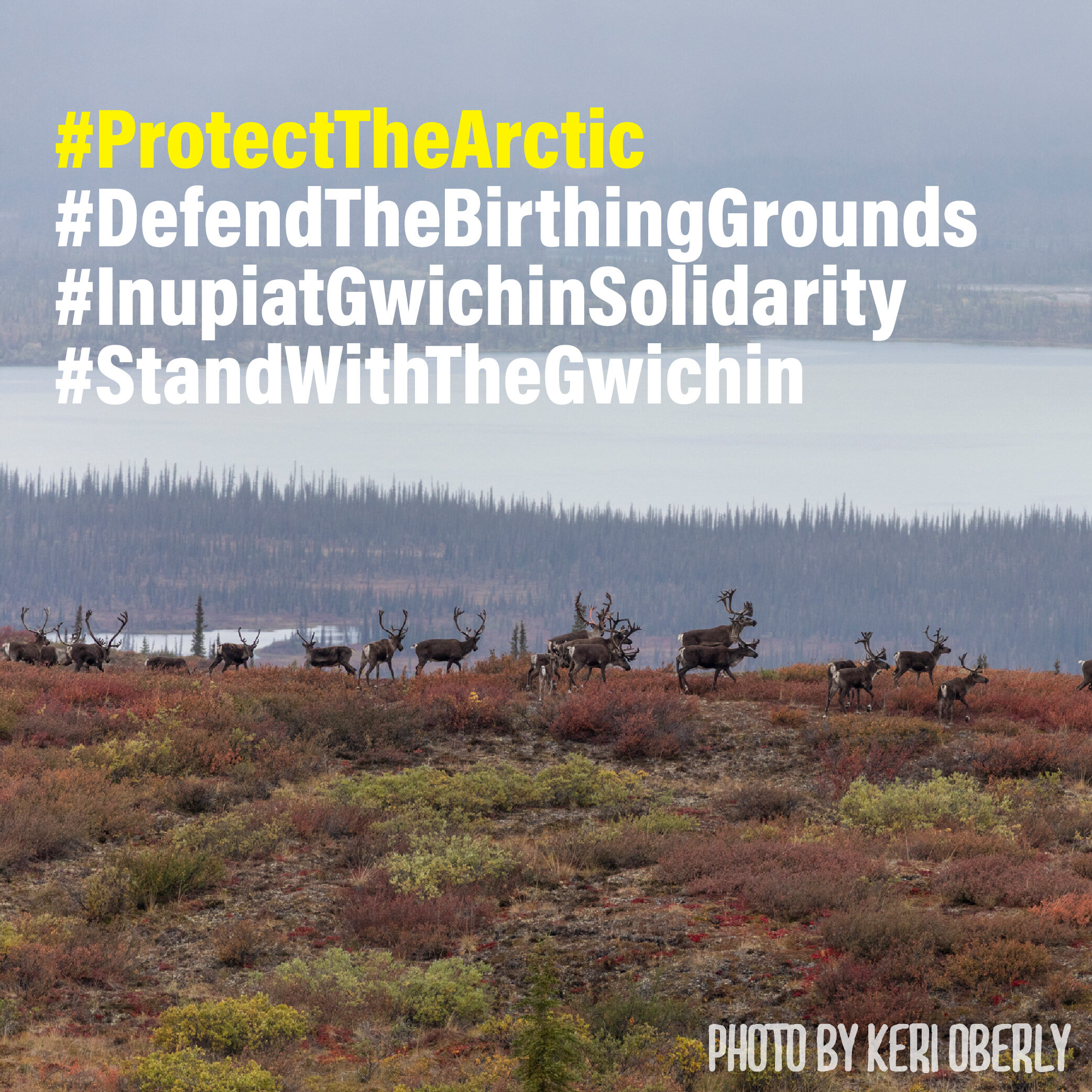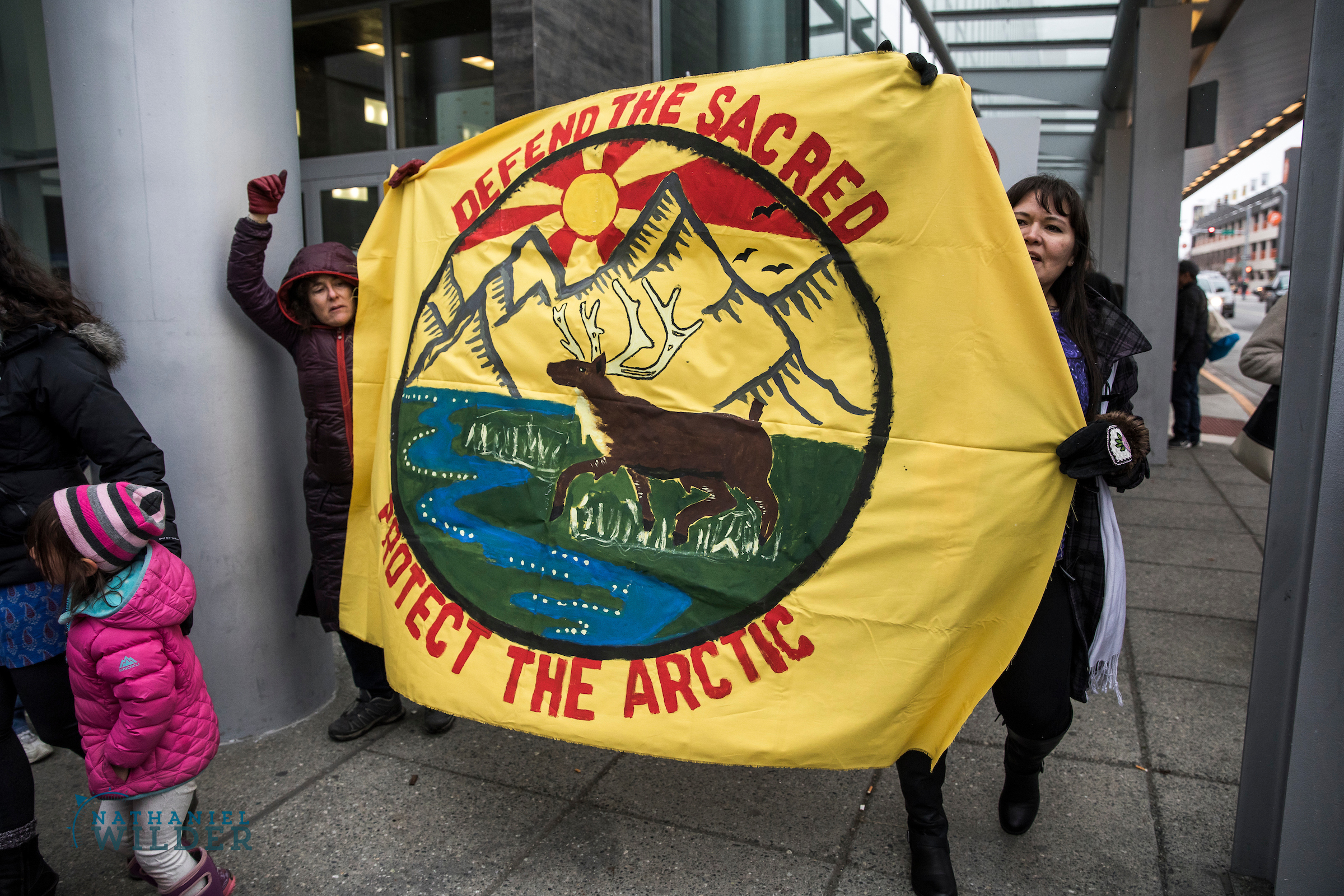Protect the Arctic Refuge • Action Toolkit
Iizhik Gwats’an Gwandaii Goodlit
The Sacred Place Where Life Begins • This solidarity toolkit is intended to be a guide for allied protectors. Below is a brief history of Indigenous organizing, guiding principles, and a call to action. What happens in the Arctic happens to the World.
Click Here >>> Download this graphic for your own banners or posters!
Defend the Sacred Alaska calls on all Protectors to rise up in solidarity with the Gwichʼin and Iñupiat peoples. We call on you to Defend the Arctic National Wildlife Refuge from oil exploration and extraction. The era of big oil is over. We can figure out how to fund state infrastructure with diverse revenue sources. We are at a critical moment for our elected leaders and AIDEA to invest locally and fund the future Alaska needs and deserves and that builds economic resilience through a just, clean-energy economy. This is why we invite our allied protectors to hold public events to show wide-spread public opposition to drilling in the Arctic Refuge. Defend the Sacred Alaska, Native Movement, and Gwich’in Steering Committee call allies from Indigenous Nations and Protectors across Turtle Island (United States and Canada) to act in solidarity with Gwich’in and Inupiat peoples to defend the Arctic Refuge.
We commend the Biden administration’s suspension of Arctic Refuge leases and condemn the Alaska Industrial Development and Export Authority (AIDEA), a state owned corporation with a terrible track record, for ignoring the executive actions and proposing to allocate $1.5M toward Arctic Refuge oil exploration despite public opposition. For more about how Alaskans are holding AIDEA accountable visit BadAIDEA.org
Reliance on oil is a failing strategy for people, prosperity, and the planet. Alaskans can have a safe, healthy and prosperous future post-oil by capitalizing on our strengths, supporting entrepreneurial effort, and creating clean energy and conservation jobs that sustain our communities and lands.
We are mobilizing a statewide coalition to hold AIDEA accountable to the long term interests of Alaskans, fight the Arctic Refuge leases and pressure them to honor their mission to promote a healthy and diverse economy through sound investments.
What You Can Do:
RISE UP WITH GWICH’IN AND IÑUPIAT protectors
Below are guidelines based on Defend the Sacred Alaska’s framework for protecting the Refuge. This is not a comprehensive or linear guide and warrants careful consideration.
Share on your SOCIAL MEDIA.
Here are some social media ready tools we have put together to help. Share posts from these local organizations and tag them: Gwichʼin Steering Committee, Native Movement, Defend the Sacred AK, and SILA.
Use these hashtags: #StandWithTheGwichin, #InupiatGwichinSolidarity #ProtectTheArctic and tag us @DefendTheSacredAK
Write LETTERS to the EDITOR of your local or state newspaper. Keep this issue in the media. Get your friends together and write letters to the editor and send them to all the newspapers you can think of.
Plan a Solidarity Action in your community:
***Due to the Covid-19 Pandemic, Defend the Sacred AK does not promote public gatherings or rallies because of concern for public health. We support individual actions that would include social distancing, but we remain concerned for everyone’s health and wellness. The information below can be adapted for socially-distanced banner drops and rally specific tips may still be relevant as we look into the future.
BANNER DROP CALL TO ACTION
Ideal locations would be the nearest BLM headquarters, a bank or insurance company that backs the fossil fuel industry, or the office of an oil company.
Notify the media for coverage: Write a press advisory detailing why you are taking action on the issue and send it to all the local, regional, and state media outlets (print, broadcast, podcast, radio, etc.). Be sure to include location and time of event so media outlets will know where to show up.
Consider letting Native Movement and Gwich’in Steering Committee know so we can connect you into the National solidarity actions. If you’re throwing down please fill out this form - or donʼt, do whatever feels safest to you - just make sure that you share out media from your action!
Help us build a collective loud voice opposing oil drilling in the Arctic Refuge! Take a video of yourself telling us why the Refuge is important to protect.
Directions:
“ My name is ____________ I am State Tribe Here and I oppose lease sales in the Arctic Refuge because _____________________________________________________________________________________________________________________________. “
#ProtectTheArctic
#DefendTheBirthingGrounds
#InupiatGwichinSolidarity
#StandWithTheGwichin
Use your phone to record yourself on video.
Hold the camera vertically.
Tell us your name, your tribal affiliation and/or the Indigenous territories you are on.
Tell us your reason for opposing lease sales on the Coastal Plain of the Arctic Refuge.
Post your video to social media use the hashtag #protectthearctic or share with us directly!
We invite bold, strategic and meaningful actions. As always, consider your safety and the safety of others in planning.
Background
In Gwich’in Iizhik Gwats’an Gwandaii Goodlit means The Sacred Place Where Life Begins.
Across the nation, this place is otherwise known as the “1002 area” of the Arctic National Wildlife Refuge. In 1987, Congress designated 1.5-million-acres of the coastal plain (section 1002) of the Arctic National Wildlife Refuge to be reserved for potential oil and gas exploration and to be protected as habitat for critical species in the North.
Located in North East Alaska along the Beaufort sea, the “1002 area” is sacred to Indigenous people and home to numerous species of animals, who have migrated and lived in relation to that part of the earth for over 10,000 years. Furthermore, this section of the coastal plain is the birthing grounds for the Porcupine Caribou Herd, one of the largest migratory caribou herds in North America.
The Porcupine Caribou Herd knows no borders akin to their relatives the Gwich’in and Inupiaq, whose Peoples have lived in relationship across what is today known as Canada and Alaska’s arctic. The Porcupine Caribou Herd has the longest land migration of any animal in the world, because Indigenous Peoples are the original keepers of the ecosystem of the Arctic National Wildlife Refuge (including the “1002 area”) which needs to remain protected from industry and climate change. They continue to protect the land and their way of life. into the future.
With Trump’s election, the Alaska Congressional delegation Young, Sullivan, and Murkowski moved swiftly, creating and pushing a fast track bill to throw out protections for the Sacred Place Where Life Begins (1002 area).
TheTax Act, which passed in December 2017, included a provision mandating leasing and development in the 1002 area. The administration has repeatedly demonstrated their willingness to pursue “energy dominance” over democratic process.
Our Federal and State leaders pursue exploitation over honoring the sacred relationship between people and the land. They do not care about the safety and protection of the Arctic National Wildlife Refuge, the Indigenous Peoples who are connected to this land, and all of the earth which is being threatened by rapid climate change. In 2018, Alaska Governor Dunleavy met with Trump in Washington D.C., where he states “The President understands that Alaska is America’s natural resource warehouse.” And every action Dunleavy has taken since his first day in office has been a direct threat to the lives of Indigenous Peoples and the ecosystems of Alaska. Defend the Sacred Alaska is standing up and saying no more, enough is enough. We can not continue a last frontier logic and contribute to global greenhouse emissions while exploiting Indigenous peoples, stripping them of their lives and relationship to their environment.
ALASKA IS #NOTYOURWAREHOUSE.
Lease Sale Update: On January 6th the Arctic Refuge Lease Sale attracted no serious industry bidders and brought in only slightly more than $14 million, a tiny fraction of the more than $1.8 billion in revenue budgeted for in the 2017 Tax Act. Over $12 million came from the primary bidder, state-owned AIDEA, who bid on 11 of the 22 offered tracts in the Arctic Refuge lease sale winning 9 of those and moved forward on 7. Two other bidders made only one bid each. (Regenerate Alaska, Inc. which is part of the Australian-based company 88 Energy & Knik Arm Services, LLC which is owned by Anchorage resident Mark Allan Graber).
On their first day in office the Biden-Harris administration issued an executive order declaring a temporary moratorium on oil and gas leasing activities in the Refuge. Governor Dunleavy’s immediate statement in response is indicative of the uphill battle ahead, and likely increased onslaught of state attacks on Alaska’s lands and waters despite a more climate-engaged federal administration.
November 2020 Update: On November 17th, 2020 the “Call for Nominations” carved up the entire coastal plain into tracts that companies are now nominating to lease for oil extraction. It also opens a 30 day comment period about what areas should be leased. The BLM is limiting comments to just snail mail (State Director, Bureau of Land Management, Alaska State Office, 222 West 7th Avenue, Mailstop 13, Anchorage, AK 99513-7504) or you can email your comments to emily@northern.org and we will hand deliver them to the Anchorage BLM office.
ROD Update: On August 17th, 2020 the Record of Decision (on the Final Environmental Impact Statement) was released, selecting Alternative B which is the most egregious and harmful option and opens the entire coastal plan to oil extraction.
April 2020 UPDATE: The Trump Administration has used the COVID-19 Pandemic to forgo the EPA regulations and continue an aggressive attack to open up sacred lands throughout Alaska for a multitude of development projects that would have far reaching impacts on our environment and Indigneous way of life. We are seeing this beyond the refuge: in the Tongass National Forest in Tlingit and Haida lands, in the Inupiaq communities facing further oil project advancement, Pebble Mine in Bristol Tribal communities, Yukon Flats oil exploration projects in Gwich’in and Koyukon villages in the Interior, and other sacred lands (aka public lands) being attacked under pandemic while EPA restrictions and laws have been relaxed and in some cases dismissed.
Every aspect of Indigenous life is interwoven with connection to the land through food, culture, and spirituality. Stripping the land of protections from fossil fuel extraction, specifically the Sacred Place Where Life Begins, the government is sending a clear message that they do not care about the fundamental rights of Indigenous Peoples. As their actions are directly threatening the rights of mother earth and the rights of Indigenous Peoples.
Indigenous Peoples of the Arctic, the Gwich’in and Inupiaq, have stewarded their lands and the sacred place where life begins since time immemorial. They have and will continue to lead the efforts in defending the sacred in past, present, and future.
Defend the Sacred Alaska is an Alaskan movement to boldly uplift our sacred connection to each other, the earth, and all living beings.
principles for acting in solidarity with Arctic Peoples
Defend the Sacred Alaska follows the Jemez Principles as well as the following protocols, which were carefully crafted with our partners, specifically to guide work in the Arctic. We ask you to follow them closely in order to act in solidarity with, and be accountable to, Alaska Native Peoples as we work together to protect the Arctic.
#1 Be Inclusive
Include Arctic People in advocacy about Arctic lands, waters and wildlife, who’s survival depends on their protection. Our campaign strategies must include Indigenous groups or organizations and ensure that the leadership of those partner organizations are included in the development of those strategies. This includes media and communications development, event planning, and long-term campaign strategy.
#2 Emphasis on Bottom-Up Organizing
Include local organizing from local people as a critical strategy. The success of our collective work depends on building a diverse base of support engaging and organizing at the local level, centering impacted communities and building outwardly. Trusting, empowering and amplifying Alaska strategies, communications, and leadership is key to success. This requires meaningfully increasing the capacity of impacted communities to ensure they are able to collaboratively engage in messaging development, strategic pathways, and movement building. Impacted communities do not need saving -- their leadership is in place and simply needs to be supported as the key strategy it is.
#3 Let People Speak for Themselves
Be curious and don’t assume: Clarify roles, representation, and accountability structures regularly. In order to build trust and understand the differing dynamics present for differing organizations, we cannot assume that we know all about one another. We must make intentional space for reflecting and clarifying our roles, representations, and accountability processes.
#4 Work Together In Solidarity and Mutuality
Make efforts to meaningfully align visions. When developing campaign strategies and goals for work in the Arctic, ensure local communities and organizations are included from the beginning. Actively seek alignment for a long-term vision and incorporate goals of solidarity in campaign strategies.
#5 Build Just Relationships Among Ourselves
Support just and equitable resource sharing amongst coalition members. Groups bring different levels and kinds of resources, including funding and expertise, to coalitions. To promote equitable and effective access to resources, groups should identify and articulate what they need and can contribute to the coalition’s success. Jointly raising funds is necessary but not sufficient. Groups also should examine where they can directly share resources that they enjoy disproportionately and help strengthen and build relationships with other groups by responding to their articulated needs.
#6 Commitment to Self-Transformation
Engage in ongoing organizational and individual learning and unlearning for transformative and adaptive change. Success depends upon a commitment to regular and consistent trainings, practices, and evaluations of ourselves and our organizations to build deep intersectional analysis. Coalition partners need to make time for reflection, growth, and adaptation while building trust and accountability to each other and ourselves. Staff and board involved in Arctic advocacy must prioritize training, resources, actionable practices, and check-ins for growth and accountability.
Be accountable to each other for group growth. It will be important for coalitions, as they adopt these Protocols, to build meaningful accountability measures and commit to each other to follow them, constructively and generously. The subgroup believes these should be developed together, through an open dialogue on how best to build trust, while ensuring organizations and individuals have the ability to process and resolve breaks in protocol fairly and with the goal of continued growth.
The Jemez Principles and other environmental justice documents can be downloaded from: www.ejnet.org/ej/
In solidarity with the Wet’suwet’en, Defend the Sacred Alaska calls on our allies to take action to stop extraction in the US and Canada. Below are resources on Allyship and Solidarity directly from the Wet’suwet’en 2020 Supporter Toolkit.
ALLYSHIP AND SOLIDARITY
An example of how to show up in a good way, by Dr. Lynn Gehl: The Ally Bill of Responsibilities
Everyone Calls Themselves An Ally, by Ancestral Pride.
Allyship and Solidarity Guidelines, on Unsettling America.
Beginner’s guide to identifying Cultural Appropriation.





